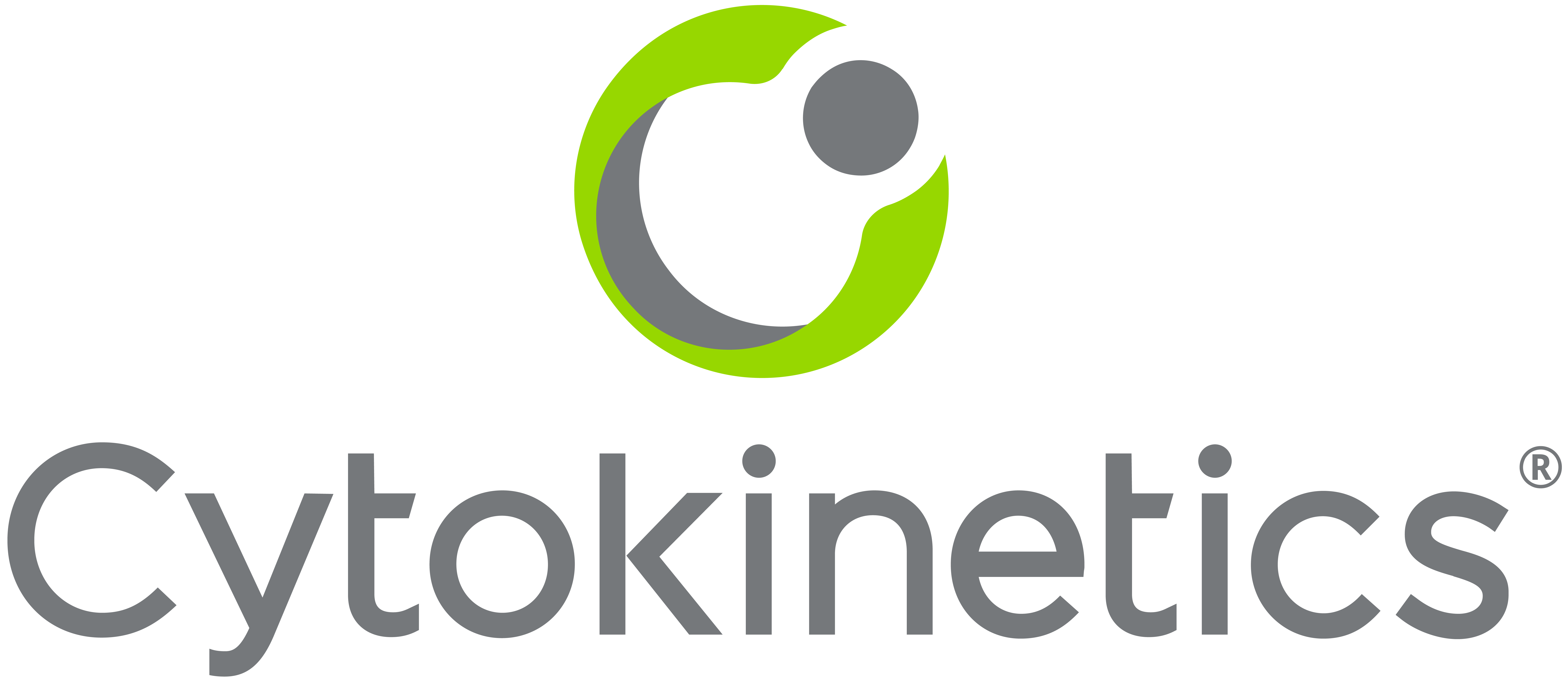Cytokinetics Announces Start of ACACIA-HCM, a Pivotal Phase 3 Clinical Trial of Aficamten in Patients With Symptomatic Non-Obstructive Hypertrophic Cardiomyopathy
“As the first Phase 3 clinical trial of aficamten in non-obstructive hypertrophic cardiomyopathy, ACACIA-HCM represents an important advancement in the development program for aficamten alongside our two ongoing Phase 3 clinical trials in obstructive HCM,” said
ACACIA-HCM: Clinical Trial Design
ACACIA-HCM is a Phase 3, multi-center, randomized, double-blind, placebo-controlled clinical trial designed to evaluate the effect of aficamten compared to placebo on health-related quality of life in participants with symptomatic nHCM. The primary endpoint is the change in Kansas City Cardiomyopathy Questionnaire (KCCQ) Clinical Summary Score from baseline to Week 36. Secondary endpoints include the change from baseline to Week 36 in maximal exercise performance (peak VO2) and sub-maximal exercise performance (Ve/VCO2), the proportion of patients with ≥1 class improvement in
ACACIA-HCM is expected to enroll 420 patients, randomized on a 1:1 basis to receive aficamten or placebo. Randomization will be stratified by persistent atrial fibrillation and presence of intracavitary obstruction. At screening, patients enrolled in ACACIA-HCM must have a resting left ventricular outflow tract gradient (LVOT-G) < 30 mmHg and post-Valsalva LVOT-G < 50 mmHg in addition to left ventricular ejection fraction (LVEF) ≥ 60%, respiratory exchange ratio (RER) ≥ 1.00 and peak VO2 ≤ 90% predicted, NT-proBNP ≥ 300 pg/mL or ≥ 900 pg/mL if atrial fibrillation or atrial flutter are present at screening, NYHA functional class II or III and KCCQ Clinical Summary Score ≥ 30 and ≤ 85.
ACACIA-HCM will consist of two parts, with Part 1 comprising Day 1 to Week 36 and Part 2 comprising Week 36 to Week 72. All participants will complete Part 1. At the end of Part 1, participants will continue into Part 2 until the last randomized participant has completed Part 1. Each patient will receive up to four escalating doses of aficamten or placebo based on echocardiographic guidance. Patients receiving aficamten will begin with 5 mg dosed once daily. At weeks 2, 4 and 6 patients will receive an echocardiogram to determine if they will be up-titrated to escalating doses of 10, 15 or 20 mg. Dose escalation will occur only if a patient has an LVEF ≥ 60%. Patients who do not meet escalation criteria will continue to receive their current dose or may be down-titrated if their LVEF is < 50%. Patients who complete ACACIA-HCM will be eligible to participate in an open-label extension clinical trial. Additional information can be found on www.clinicaltrials.gov.
About Aficamten and the Broad Phase 3 Clinical Trials Program
Aficamten is an investigational selective, small molecule cardiac myosin inhibitor discovered following an extensive chemical optimization program that was conducted with careful attention to therapeutic index and pharmacokinetic properties and as may translate into next-in-class potential in clinical development. Aficamten was designed to reduce the number of active actin-myosin cross bridges during each cardiac cycle and consequently suppress the myocardial hypercontractility that is associated with hypertrophic cardiomyopathy (HCM). In preclinical models, aficamten reduced myocardial contractility by binding directly to cardiac myosin at a distinct and selective allosteric binding site, thereby preventing myosin from entering a force producing state.
The development program for aficamten is assessing its potential as a treatment that improves exercise capacity and relieves symptoms in patients with HCM as well as its potential long-term effects on cardiac structure and function. Aficamten is currently the subject of SEQUOIA-HCM (Safety, Efficacy, and Quantitative Understanding of Obstruction Impact of Aficamten in HCM), a pivotal Phase 3 clinical trial in patients with symptomatic obstructive hypertrophic cardiomyopathy (HCM), MAPLE-HCM (Metoprolol vs Aficamten in Patients with LVOT Obstruction on Exercise Capacity in HCM), a Phase 3 clinical trial evaluating aficamten as monotherapy compared to metoprolol as monotherapy in patients with obstructive HCM, and ACACIA-HCM (Assessment Comparing Aficamten to Placebo on Cardiac Endpoints In Adults with Non-Obstructive HCM), a pivotal Phase 3 clinical trial in patients with symptomatic non-obstructive HCM. Results from SEQUOIA-HCM are expected by the end of 2023. Aficamten received Breakthrough Therapy Designation for the treatment of symptomatic obstructive HCM from the
About Hypertrophic Cardiomyopathy
Hypertrophic cardiomyopathy (HCM) is a disease in which the heart muscle (myocardium) becomes abnormally thick (hypertrophied). The thickening of cardiac muscle leads to the inside of the left ventricle becoming smaller and stiffer, and thus the ventricle becomes less able to relax and fill with blood. This ultimately limits the heart’s pumping function, resulting in reduced exercise capacity and symptoms including chest pain, dizziness, shortness of breath, or fainting during physical activity. HCM is the most common monogenic inherited cardiovascular disorder, with approximately 280,000 patients diagnosed in the
About
For additional information about
Forward-Looking Statements
This press release contains forward-looking statements for purposes of the Private Securities Litigation Reform Act of 1995 (the “Act”). Cytokinetics disclaims any intent or obligation to update these forward-looking statements and claims the protection of the Act’s Safe Harbor for forward-looking statements. Examples of such statements include, but are not limited to, statements express or implied relating to the properties or potential benefits of aficamten or any of our other drug candidates and our ability to fully enroll ACACIA-HCM. Such statements are based on management’s current expectations, but actual results may differ materially due to various risks and uncertainties, including, but not limited to the risks related to Cytokinetics’ business outlines in Cytokinetics’ filings with the Securities and Exchange Commission. Forward-looking statements are not guarantees of future performance, and Cytokinetics’ actual results of operations, financial condition and liquidity, and the development of the industry in which it operates, may differ materially from the forward-looking statements contained in this press release. Any forward-looking statements that Cytokinetics makes in this press release speak only as of the date of this press release. Cytokinetics assumes no obligation to update its forward-looking statements whether as a result of new information, future events or otherwise, after the date of this press release.
CYTOKINETICS® and the
Contact:
Senior Vice President, Corporate Communications, Investor Relations
(415) 290-7757
References:
- CVrg: Heart Failure 2020-2029, p 44; Maron et al. 2013 DOI: 10.1016/S0140-6736(12)60397-3; Maron et al 2018 10.1056/NEJMra1710575
Symphony Health 2016-2021 Patient Claims Data DoF;- Maron MS, Hellawell JL, Lucove JC,
Farzaneh-Far R , Olivotto I. Occurrence of Clinically Diagnosed Hypertrophic Cardiomyopathy inthe United States . Am J Cardiol. 2016; 15;117(10):1651-1654. - Gersh, B.J., Maron, B.J., Bonow, R.O., Dearani, J.A., Fifer, M.A., Link, M.S., et al. 2011 ACCF/AHA guidelines for the diagnosis and treatment of hypertrophic cardiomyopathy. A report of the
American College of Cardiology Foundation/American Heart Association Task Force on practice guidelines.Journal of the American College of Cardiology and Circulation , 58, e212-260. - Hong Y, Su WW,
Li X. Risk factors of sudden cardiac death in hypertrophic cardiomyopathy. Current Opinion in Cardiology. 2022Jan 1 ;37(1):15-21

Source: Cytokinetics, Incorporated




